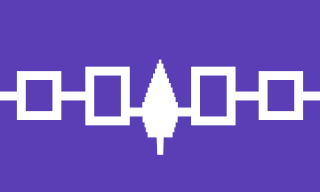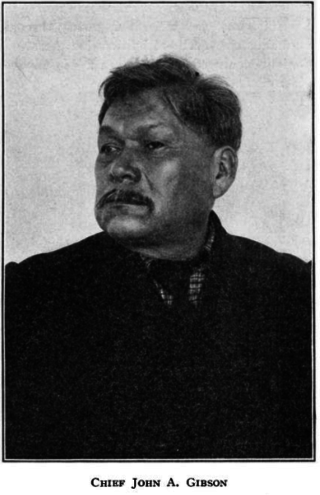Related Research Articles

Hiawatha, also known as Ayenwatha or Aiionwatha, was a precolonial Native American leader and cofounder of the Iroquois Confederacy. He was a leader of the Onondaga people, the Mohawk people, or both. According to some accounts, he was born an Onondaga but adopted into the Mohawks.

Among the Haudenosaunee the Great Law of Peace, also known as Gayanashagowa, is the oral constitution of the Iroquois Confederacy. The law was written on wampum belts, conceived by Dekanawidah, known as the Great Peacemaker, and his spokesman Hiawatha. The original five member nations ratified this constitution near modern-day Victor, New York, with the sixth nation being added in 1722.
The Beaver Wars, also known as the Iroquois Wars or the French and Iroquois Wars, were a series of conflicts fought intermittently during the 17th century in North America throughout the Saint Lawrence River valley in Canada and the Great Lakes region which pitted the Iroquois against the Hurons, northern Algonquians and their French allies. As a result of this conflict, the Iroquois destroyed several confederacies and tribes through warfare: the Hurons or Wendat, Erie, Neutral, Wenro, Petun, Susquehannock, Mohican and northern Algonquins whom they defeated and dispersed, some fleeing to neighbouring peoples and others assimilated, routed, or killed.
The Seneca are a group of Indigenous Iroquoian-speaking people who historically lived south of Lake Ontario, one of the five Great Lakes in North America. Their nation was the farthest to the west within the Six Nations or Iroquois League (Haudenosaunee) in New York before the American Revolution. For this reason, they are called “The Keepers of the Western Door.”

The Onondaga people are one of the five original nations of the Haudenosaunee (Iroquois) Confederacy in the Northeastern Woodlands. Their historical homelands are in and around present-day Onondaga County, New York, south of Lake Ontario.

The Oneida people are a Native American tribe and First Nations band. They are one of the five founding nations of the Iroquois Confederacy in the area of upstate New York, particularly near the Great Lakes.

The Kahnawake Mohawk Territory is a First Nations reserve of the Mohawks of Kahnawá:ke on the south shore of the Saint Lawrence River in Quebec, Canada, across from Montreal. Established by French Canadians in 1719 as a Jesuit mission, it has also been known as Seigneury Sault du St-Louis, and Caughnawaga. There are 17 European spelling variations of the Mohawk Kahnawake.

Kanesatake is a Mohawk settlement on the shore of the Lake of Two Mountains in southwestern Quebec, Canada, at the confluence of the Ottawa and Saint Lawrence rivers and about 48 kilometres (30 mi) west of Montreal. People who reside in Kanehsatà:ke are referred to as Mohawks of Kanesatake. As of 2022, the total registered population was 2,751, with a total of about 1,364 persons living on the territory. Both they and the Mohawk of Kahnawake, Quebec, a reserve located south of the river from Montreal, also control and have hunting and fishing rights to Doncaster 17 Indian Reserve.

The Mohawks of the Bay of Quinte (MBQ) are a Mohawk community within Hastings County, Ontario. They control the Tyendinaga Mohawk Territory, which is a 7,362.5 ha (18,193-acre) Mohawk Indian reserve on the Bay of Quinte in southeastern Ontario, Canada, east of Belleville and immediately to the west of Deseronto. They also share Glebe Farm 40B and the Six Nations of the Grand River reserves with other First Nations.
The Covenant Chain was a series of alliances and treaties developed during the seventeenth century, primarily between the Iroquois Confederacy (Haudenosaunee) and the British colonies of North America, with other Native American tribes added. First met in the New York area at a time of violence and social instability for the colonies and Native Americans, the English and Iroquois councils and subsequent treaties were based on supporting peace and stability to preserve trade. They addressed issues of colonial settlement, and tried to suppress violence between the colonists and Indian tribes, as well as among the tribes, from New England to the Colony of Virginia.
The Haudenosaunee was formed around the Great Law of Peace Kaianere'kó:wa, a constitution detailing a shared value system which informs the policy and economics of their society.
The Great Peacemaker, sometimes referred to as Deganawida or Tekanawí:ta was by tradition, along with Jigonhsasee and Hiawatha, the founder of the Haudenosaunee, commonly called the Iroquois Confederacy. This is a political and cultural union of six Iroquoian-speaking Native American tribes governing parts of the present-day state of New York, northern Pennsylvania, and the eastern portion of the provinces of Ontario, and Quebec Canada, recognized as sovereign by both the USA and Canada.

The Cayuga Nation of New York is a federally recognized tribe of Cayuga people, based in New York, United States. Other organized tribes with Cayuga members are the federally recognized Seneca-Cayuga Tribe of Oklahoma and the Canadian-recognized Six Nations of the Grand River First Nation in Ontario, Canada.

Conrad Weiser, born Johann Conrad Weiser, Jr., was a Pennsylvania Dutch (German) pioneer who served as an interpreter and diplomat between the Pennsylvania Colony and Native American nations. Primarily a farmer, he also worked as a tanner, and later served as a soldier and judge. He lived part of the time for six years at Ephrata Cloister, a Protestant monastic community in Lancaster County.

The Iroquois, also known as the Five Nations, and later as the Six Nations from 1722 onwards; alternatively referred to by the endonym Haudenosaunee are an Iroquoian-speaking confederacy of Native Americans and First Nations peoples in northeast North America. They were known by the French during the colonial years as the Iroquois League, and later as the Iroquois Confederacy, while the English simply called them the "Five Nations". The peoples of the Iroquois included the Mohawk, Oneida, Onondaga, Cayuga, and Seneca. After 1722, the Iroquoian-speaking Tuscarora people from the southeast were accepted into the confederacy, from which point it was known as the "Six Nations".

Tadodaho was a Native American Hoyenah (sachem) of the Onondaga nation before the Deganawidah and Hiawatha formed the Iroquois League, or "Haudenosaunee". According to oral tradition, he had extraordinary characteristics and was widely feared, but he was persuaded to support the confederacy of the Five Nations.

John Arthur Gibson (1850–1912) was a chief of the Seneca nation of the North American Iroquois confederation. Part Onondaga and part Seneca, he resided within the reserve of the Six Nations of the Grand River in Ontario, Canada. Knowledgeable about Iroquois (Haudosaunee) culture, he is best known for the versions he provided of the Iroquois oral constitution, the Great Law of Peace. He acted as an advisor to the Canadian Department of Indian Affairs in matters relating both to Iroquois and non-Iroquois indigenous people. He was a well-respected player of the traditional Iroquois sport of lacrosse until he was blinded during a game when he was 31.
Seth Newhouse was a leader of the Iroquois confederacy. He advocated for their self-government in the Grand River region of Ontario and worked to record and preserve traditions of the people. In 1885 he arranged a manuscript version of the Great Law of Peace, which has been analyzed since, particularly for its faithfulness to the original.
Leon Shenandoah was an Onondaga politician who headed the Haudenosaunee (Iroquois) Confederacy from 1968 to his death.

The Royaner are the hereditary male clan leaders within the Haudenosaunee Confederacy. They are chosen by their respective Yakoyaner to represent their clan at the confederacy level. The specific name-titles held by the royaner belong to the matrilineal lineages headed by the clan mothers. These male leaders are expected to serve their community for life, although there are ways of removing a royaner if he does not live up to his lineage's expectations. With the clan mothers, the royaner form the hereditary leadership that distinguishes itself from the elected Band Council imposed by the Canadian state.
References
- 1 2 "Government" . Retrieved 21 February 2021.
- ↑ Schlesinger, Arthur M. Jr (17 September 1998). The Disuniting of America: Reflections on a Multicultural Society . W. W. Norton & Company; Revised and Enlarged Edition (September 17, 1998). ISBN 0393318540.